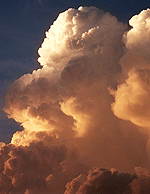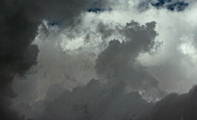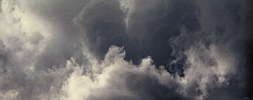 We
don't get Tornadoes here We
don't get Tornadoes here
Australians
are funny about tornadoes. Most of us have a strong belief that they don't occur
here. It's hard to shake. Sure, we have violent thunderstorms. Hailstones as big
as cricket balls. Violent winds that blow down trees over wide areas. But no tornadoes.
They only occur in America -- like in the movie Twister. In America but not here.
We get
tropical cyclones. They call them hurricanes in America. Everybody here who's
old enough remembers when Cyclone Tracy devastated Darwin on Christmas Eve in
1974. But suggest that winds from a violent thunderstorm that destroy property
or take lives might be a tornado, and everyone talks about damaging wind gusts
or mini-cyclones. Never tornadoes.
We have
dust devils. They're know locally as willy-willies. Most of us who have driven
out in the Bush during a summer drought have seen them. Columns of swirling dust
being sucked high into the clear blue sky. My brother even ran into one, once.
He says it was cool inside. Plenty of people have seen water spouts descending
from storms out to sea. But tornadoes? No. We don't get tornadoes here.
I grew
up with this belief too. A year or so ago, I learnt otherwise.
We drove
down to the coast one morning in mid April. We were visiting my wife's parents
who live in Merimbula. It's a picturesque holiday town set in the Bush, on an
inlet from the Pacific, in the south eastern corner of the continent. The day
was already warm when we left. The Autumn sun still had a kick to it. As we drove
south from Canberra, there were signs of castellatus in the sky, indicating unstable
weather. Thick wisps of cirrus were moving in from the south west. A cold front
was on its way. Violent thunderstorms were forecast for the south east of the
state for that evening.
But the
day was sunny and pleasant and we enjoyed the three hour drive down. Winter would
be here in a month or so, so the warmth was welcome.
We reached
Merimbula in time for lunch. The house is built on a ridge, half way down from
the hilltop to the lake shore. The view is spectacular. It looks out over the
lake to the south, across to the sandy spit known as Fishpen, and beyond to the
Pacific Ocean. In the distance you can see the hamlet of Pambula Beach. It also
gives an excellent view of approaching weather.
 By
mid afternoon the clouds had started to build over the mountains to the west.
By late afternoon the clouds were thickening and starting to move over us from
the north west. The local AM radio station was being interrupted by bursts of
lightning static. Thunderstorms were on the way. It would be a boisterous night. By
mid afternoon the clouds had started to build over the mountains to the west.
By late afternoon the clouds were thickening and starting to move over us from
the north west. The local AM radio station was being interrupted by bursts of
lightning static. Thunderstorms were on the way. It would be a boisterous night.
 We
heard the first rumble of thunder around six o'clock. The sun had set and the
clouds were bringing darkness earlier than normal. There followed more flashes
of lighting. The air was still but the delay between lightning flash and thunder
was diminishing. A big storm was approaching. Perhaps more than one. We
heard the first rumble of thunder around six o'clock. The sun had set and the
clouds were bringing darkness earlier than normal. There followed more flashes
of lighting. The air was still but the delay between lightning flash and thunder
was diminishing. A big storm was approaching. Perhaps more than one.
 We
ate the evening meal to the accompaniment of the lightning and thunder, and bursts
of heavy rain. With the dishes cleared away, we turned the television on. This
was more to distract us from the increasingly fierce storm outside than because
there was anything worth watching. It would probably have been smarter to leave
it off and avoid electrical damage from a lightning strike. No-one would admit
they were worried. We
ate the evening meal to the accompaniment of the lightning and thunder, and bursts
of heavy rain. With the dishes cleared away, we turned the television on. This
was more to distract us from the increasingly fierce storm outside than because
there was anything worth watching. It would probably have been smarter to leave
it off and avoid electrical damage from a lightning strike. No-one would admit
they were worried.
After
a while we stopped paying attention to the television and talked about the storm.
It was violent indeed. The wind came in great gusts, its roar blurring into the
continuous boom of the thunder. The tall eucalypts were being torn back and forth
violently by the wind. Every few seconds they were lit in ghastly brilliance against
the blackness of the sky, or silhouetted against the lightning-lit clouds.
As the
storm reached its peak, during a particularly violent gust, we heard the heavy
tiles on the roof lift and clatter back into place, as if some giant vacuum cleaner
had briefly sucked them up and released them again.
But then
the peak passed. After another hour, the storms had subsided. The main centre
had moved south and east. Gradually the wind decreased in strength and the lightning
moved into the distance. The rain stopped. The remainder of the night was quiet,
the stillness broken only by the chirp of crickets and distant frogs.
The next
morning I was woken at seven thirty by the telephone. It was my mother calling
from Canberra. She sounded worried. "Are you allright?" she asked.
"Of
course I'm allright", I replied. "Why shouldn't I be?"
"The
tornado", she answered. "We just heard it on the news. The Merimbula
tornado".
"What??
What tornado??" I was startled.
"It
was on the radio. They said that Merimbula was hit by a tornado last night at
about eight. Over a hundred houses smashed to bits and damage everywhere. It went
right through the middle of the town."
"Good
heavens" was all I could think to say. I collected my thoughts. "Well,
there was an exceptionally violent thunderstorm last night. And the wind rattled
the roof tiles briefly at one point. But so far as I know there's nothing damaged
around here."
I reassured
her that, yes, we were fine and nothing was damaged nearby, and we were quite
safe.
I went
out onto the deck. It was a fine bright sunny autumn morning. Not a trace of the
previous night's violence. None of the nearby trees were damaged. There were a
few small branches scattered about here and there, torn from the upper limbs,
but nothing that couldn't be explained by a normal vigorous thunderstorm.
I went
in and turned on the radio. Lots of reports of the tornado. It was the main item
on the state and national news. They interviewed people caught up in it. Everyone
called it a mini-cyclone. They wouldn't call it a tornado. Funny about that.
Miraculously
no-one had been hurt. A lot of houses had been destroyed, the bowling club badly
damaged and a motel completely wrecked. It had hit Merimbula from the north, gone
through part of the town, disappeared before it reached the main street, then
had come ashore again at Pambula Beach, a few miles south, where it had mangled
a caravan park, gone up the hill and had left a trail of devastated houses, before
disappearing into the Bush.
We decided
to go into town and see for ourselves. The roads were closed in several places,
so we had to work our way around back streets to get into the middle of town.
There were yellow State Emergency Service vehicles everywhere, and the place was
crawling with people in SES uniforms. There were also plentiful signs of recent
devastation. Trees smashed, their trunks torn in half. The main town car park
was covered in building debris. Smashed timber, roofing iron all over the place,
and yellow fibreglass insulation draped over power lines. Immediately above the
car park were the remains of a motel, its entire upper story removed and spread
around the district. People had started to collect the debris into a huge pile.
We walked
up the hill, past all the mess. Everywhere you could see the damage. Road signs
twisted and bent over sideways. Trees decapitated. The bowling club had been damaged
badly. Roofing lifted, windows smashed, the lawns on the bowling greens neatly
rolled up into giant Swiss Rolls and dumped over a ten foot fence into the adjacent
tennis courts. We heard somebody say something about a woman who had been sitting
in the clubhouse in the evening, drinking. Suddenly the window was sucked out
and she started to follow, dragged by the vacuum. Somebody with presence of mind
caught hold of her by the legs and stopped her from disappearing out into the
night. Another version of the story said it was a man, not a woman.
More
stories about narrow escapes were spreading among the people surveying the damage.
One said that a man had been watching the storm from his balcony to the north
of the town. Right in the damage path. Suddenly half a dozen large heavy potted
plants just below him were sucked up into the sky, pots and all, never to be seen
again. He wasn't touched. His house was wrecked.
We walked
past the club to look over the valley to the north. There was a clearly marked
trail of damage through the houses on the north of town. It was quite narrow,
only two or three houses wide. You could see more yellow SES vehicles dotting
the landscape. The houses appeared to have been totally mashed.
We left
town and drove across the bridge over the inlet to Fishpen, where we'd heard there
was more damage. A few great Coastal Banksia trees had been uprooted and torn
to bits.
Then
we headed down to Pambula Beach. The damage was just as great here too. Houses
shattered, people picking their way through the rubble of what had been comfortable
homes the day before. We felt like voyeurs and didn't stop to gawk. Again the
path of the damage was very clear.
Late
that morning the radio was broadcasting interviews with experts from the Bureau
of Meteorology. They were cautious about the cause, and said that they would need
to survey the damage patterns before they could agree whether it had been a tornado
or not. Or possibly more than one. The trails of damage did not follow a straight
line. Either the funnel took a sharp zigzag after it hit Merimbula and before
it hit Pambula Beach, or there were two separate events.
Nobody
I spoke to had seen a funnel cloud: the storm had been far too wild and the rain
too heavy. But I had no doubt. It was certainly a tornado.
Some
months later, the Bureau of Meteorology published its yearly summary of violent
weather events. The Merimbula storm was listed. As a tornado. Officially there
were at least two funnels. It has since been classified as an F2 tornado on the
Fujita scale.
We don't
get tornadoes here? Nonsense.
Copyright
© 1997 David Nicholls. This document may not be reproduced in any form without explicit permission in writing from the author
|